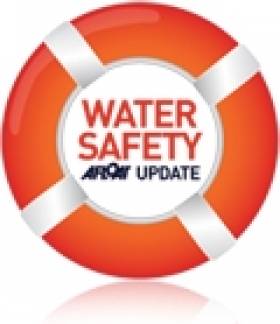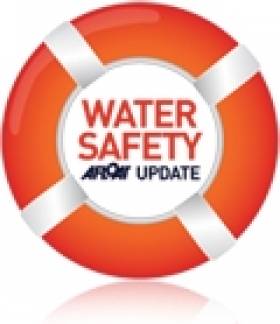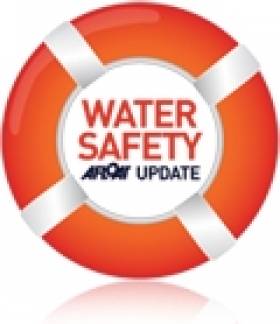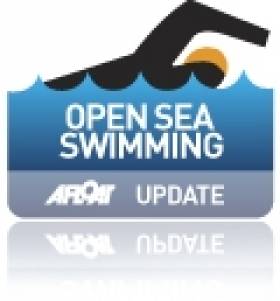Displaying items by tag: water safety
#WaterSafety - The mother of a boy who tragically died from cold water shock while swimming in open water has called on the public to be mindful that warm weather does not equal warm water.
Dylan Ramsay, 13, drowned while swimming with friends at a quarry in Lancashire three summers ago.
Though the sporty youth was regarded as a capable swimmer, Dylan was overcome by the coldness of the water in the quarry lake.
In the video above, his mother Becky expresses her profound shock and sadness at the lost of her son who may still be alive today if the public were as aware of the dangers of swimming unsupervised in open water as they are of the 'green cross code'.
The RNLI has cited cold water shock as one of the main contributing factors in accidents around Britain's coasts in 2013, which saw the highest number of water-related deaths in four years, according to ITV News.
As previously reported on Afloat.ie, Ireland fared better statistically in 2013, recording the lowest number of drownings since 1936 - though 91 people still died in the water.
And Irish Water Safety called on the public to remain vigilant, especially with news of the death of 13-year-old boy who had been swimming with friends at a water treatment plant in Drogheda earlier today (24 July).
#safetyonthewater – Irish Water Safety (IWS) has appealed to the public to stay vigilant around water and not to become another drowning statistic. This appeal comes in the wake of IWS drowning statistics for 2013 which recorded 91 drownings, the lowest for 78 years.
Following a particularly hot two weeks in July 2013 during which thirteen tragically drowned, IWS noted a marked decrease in the number of tragedies during the rest of the summer period as the public adjusted their behaviours and attitudes to staying safe. This resulted in an overall total drowning figure of 91 for 2013, the lowest since 1936 when 73 people drowned.
Males were particularly at risk, accounting for 75% of drownings in 2013. Half of all those who drowned were adults aged 30-59. An extract from Irish Water Safety's 2013 Annual Report notes that the highest figure recorded in any one year to date is 235 in 1983. There was an average of 135 drownings each year in the decade to 2013.
Extracts from Irish Water Safety's analysis reveals that*:
60% were accidents, 20% suicides and 20% undetermined (55,19,17)
53% of drownings were aged 30-59 (48); 16% of drownings were aged under 29 (16)
75% of all drownings were male (69)
60% of total male & female drownings were accidental (42 of 69 & 13 of 22)
14% of female drownings were suicide (3); 23% of male drownings were suicide (16)
In the 1970's, we averaged 91 accidental drownings each year. We ended the 00's averaging 55. In the decade to 2013, the figure dropped to 51.
In the 1980's we averaged 207 total drownings each year. We ended the 00's averaging 150. In the decade to 2013, the figure dropped to 135.
Complacency is not an option for anybody as the statistics frighteningly reveal. Although 75% of total accidental drownings were male, the adage 'boys will be boys' is muted by the fact that the vast majority of drownings were not boys at all but grown men - 53% aged 30-59, compared to 16% aged under 29."
It only takes seconds for tragedy to strike and this can so easily be avoided if people take responsibility for their own safety by taking note of the following in advance of any trip:
Swim at Lifeguarded waterways - http://www.iws.ie/bathing-areas-page.html
If there is no Lifeguarded waterway nearby then swim at a recognized, traditional bathing area
Swim within your depth - stay within your depth;
Use local knowledge to determine local hazards and safest areas to swim;
Ensure that ringbuoys are present;
Make sure that the edges are shallow shelving so that you can safely and easily enter and exit;
Only drink alcohol after your aquatic activity has ended. Stay Away From The Edge after you consume alcohol.
Never use inflatable toys at beaches, rivers or lakes.
Water Safety Chief Urges Divers To Be 'Diving Fit'
#Diving - Irish Water Safety chief John Leech has called on divers to ensure they are well trained and 'diving fit' before going underwater following the deaths of five divers in separate incidents around the Irish coast.
The latest casualty, who died after an accident off St John's Point near Killybegs in Co Donegal on Saturday (12 July) has been named as 57-year-old Presbyterian minister Rev Dr Stewart Jones from Strabane, Co Tyrone.
Speaking this morning on RTÉ Radio 1's Morning Ireland, Leech said: "Diving by its nature is not risk free - it's all a case of managing risk."
He added that "the more training you do, the less chance you have of dying."
Listen to John Leech on Morning Ireland via the RTÉ Player HERE.
New UK Figures Show 381 Water-Related Deaths In 2013
#WaterSafety - There were a total of 381 drownings and water-related deaths from accidents or natural causes across the United Kingdom in 2013, according to a report published this week by Britain's National Water Safety Forum (NWSF).
As in previous years, more than half of that number (227) were in inland waters, such as tidal and freshwater rivers, lakes and reservoirs, while fatalities at the sea, on the beach or shoreline accounted for nearly a third (115).
A further 22 deaths happened at harbours, docks, marinas and inland or coastal ports. Eight deaths occurred in the bath and six in swimming pools, while three happened in areas that are not normally watercourses such as marsh and flooded land.
The figures include deaths in water that resulted from natural causes such as a heart attack, drowning or other fatal injuries resulting from falls into water and those that occurred during the course of water-based activities.
The NWSF’s Water Incident Database (WAID) breaks down drownings and other water-related deaths by activity, age and location type. It reveals that in 2013 the five-year age group with the highest number of fatalities (31) was males aged between 20-24.
Meanwhile, 0-19s accounted for 12 per cent of deaths (46), of which more than half were teenagers aged 15 to 19 (27). In the youngest age bracket of four and under, 10 children drowned.
The peak summer months of July and August witnessed the most deaths, with 106 during this period.
The leading activities were people walking alongside water and falling in, swimming (predominantly in open water) and jumping into open water.
There were 260 deaths in England, 56 in Scotland, 41 in Wales and 11 in Northern Ireland. In England, the South West (53) and the South East (50) regions had the highest number of deaths.
NWSF deputy chair Jim Watson said: “Although the number of accidental drownings and water-related deaths has remained consistent in recent years, there should be no room for complacency, particularly as we enter the warmer summer months and more people are drawn to the water.
“We encourage people to enjoy the UK’s waters, but to make sure they understand the risks and come home safely.”
A full copy of the UK Water-Related Fatalities 2013 report can be downloaded as an Excel spreadsheet HERE.
The WAID was developed by NWSF members, including national partners the Canal and River Trust, the British Sub Aqua Club, the Maritime and Coastguard Agency, the RNLI, RoSPA and the Royal Life Saving Society; sports governing bodies; and regional and local organisations, including Cornwall Council. It was developed in partnership with the UK government's Department for Transport.
Jedward Trapped By Tide On North Dublin Beach
#WaterSafety - Pop twins Jedward have urged their fans to stay safe near the water after they got themselves into a spot of bother trapped by the tide on a sandbank in North Co Dublin last night.
As the Irish Times reports, the brothers - John and Edward Grimes - had gone for a walk on Donabate beach, north of Malahide, with a cousin last night (2 July) when they were stranded by the incoming tide and became disoriented in the fading light.
The twins' mother, who spoke to them by mobile phone, raised the alarm with the Irish Coast Guard, who launched the Skerries coastguard team and the Dublin rescue helicopter to the scene.
The Irish Times has more on the story HERE.
Coastguard Rescues Boys From Tiny Dinghy Off Howth
#WaterSafety - The Irish Coast Guard has reiterated its warning to the public not to go to sea in unsuitable craft after two children were recovered from a small dinghy off North Co Dublin on Monday evening.
As TheJournal.ie reports, a routine coastguard patrol off Howth happened upon the two boys who had set out to sea in the tiny inflatable with armbands instead of lifejackets.
The boys were taken aboard the coastguard vessel "for their own safety" and taken back to dry land at Howth Harbour.
Coastguard officials highlighted this incident as a perfect example of the kind of dangerous behaviour the public should avoid on the water.
Coastal rescue teams may get some reprieve from the hot weather over the new few days, however, with Independent.ie reporting a drop in temperatures, cloudy skies and spells of rain from tomorrow.
Teens Hospitalised After Swimming Accident
#WaterSafety - After yesterday's warning against taking risks on or near the water during the current hot spell comes news that three teenagers have been hospitalised after an accident at a lake near an apartment complex in Blanchardstown yesterday evening (20 June).
TheJournal.ie reports that a boy and two girls, all aged around 13, were rushed to Temple Street Children's Hospital after the swimming accident. As of last night the boy was said to be in critical condition.
Update 11am: RTÉ News is now reporting that the 13-year-old boy has died in hospital.
Elsewhere in Dublin, another swimming incident on Thursday 19 June saw two men rescued from a cliffside at Balscadden Bay in Howth after getting into difficulty, according to Independent.ie.
The duo struggled to swim against the strong current and eventually made it to rocks at the cliff base, but one of the men was too exhausted to continue.
They were only rescued after attracting the attention of passers-by, tourists who alerted staff at a nearby café.
Sea Jumpers Taking A Big Risk During Hot Spell
#WaterSafety - Despite Irish Water Safety's sensible advice for open sea swimming and inland water bathing during the current hot spell, some reckless souls have been taking their lives in their hands with some scary jumps into the drink.
The video above from Independent.ie shows youths leaping from a rusted old derrick into the Grand Canal as it joins the River Liffey in Dublin's Docklands.
And such dangerous dives have been echoed elsewhere, with popular spots from Howth to Dalkey springing up on social media as young people Instagram their seaside adventures. SEE BELOW FOR MORE
One place where no one's doing any diving or swimming right now is Bettystown Beach - where people have been warned away by Meath County Council over elevated levels of Ecoli and other bacteria detected in the water this week, according to TheJournal.ie.
In any case, best leave the diving to the professionals - specifically the competitors in the returning Red Bull Cliff Diving World Series.
The Meath Chronicle has the full list of elite divers who will descend on Inis Mór next weekend, including last year's winner Artem Silchenko and cliff diving legend Orlando Duque.
Rounding up some of the craziness... Robin Blandford posted this image of young people leaping from the Baily cliffs at Howth into unknown waters below:
These kids at Bullock Harbour in Dalkey were also taking a big chance jumping in so high above the water and so close to the rocks:
Perhaps they should take a leaf out of this chap's book and take the plunge from a more sensible height (provided bathing isn't prohibited, of course):
Open Sea Swimming Advice Issued by Irish Water Safety
#watersafety – Irish Water Safety is appealing to the public to stay within their depth when swimming in open water during this current spell of hot weather, following an analysis of the thirteen drownings in last years heat wave.
Swim at Lifeguarded waterways - here
If there is no Lifeguarded waterway nearby then swim at a recognized, traditional bathing area
Swim within your depth - stay within your depth;
Use local knowledge to determine local hazards and safest areas to swim;
Ensure that ringbuoys are present;
Make sure that the edges are shallow shelving so that you can safely and easily enter and exit the water;
Only drink alcohol after your aquatic activity has ended. Stay Away From The Edge after you consume alcohol.
Never bring inflatable toys or floating killers to beaches, lakes or rivers
The majority of drownings, 62%, occur inland where river and lake beds can be difficult to see and therefore extremely difficult to determine if you are swimming within your depth. The onset of cramp, combined with the panicked realisation that you are out of your depth can have tragic consequences and be compounded further by the muscle cooling effect of longer periods in open water. Bear in mind that in a recent analysis on drowning over the last 25 years we discovered that 32% of drowning victims had consumed alcohol so stay away from water when you have been drinking.
If you see someone in difficulty, these simple steps may save a life:
Shout to the casualty and encourage them to shore. This may orientate them just enough.
Reach out with a long object such a branch or a piece of clothing but do not enter the water yourself.
Throw a ringbuoy or any floating object and call 112 for the coast guard.
Friday the 13th Full Moon Water Safety Warning
#watersafety – Hot weather often lulls people into a false sense of security that will place lives at risk this weekend at beaches, rivers and lakes. Knowing the dangers will reduce the chance of drowning tragedies that average five per fortnight.
Rip-Currents - the tidal influence of a full moon on Friday 13th June will cause stronger than normal rip currents this weekend. It will be the first outdoor swim of the year for many people unaware of the dangers of swimming in open water. To escape a rip current, never swim against this narrow current of water flowing away from a beach. Instead, swim parallel to shore, out of the narrow current, then swim back to shore at an angle.
Lifeguards - swim at the lifeguarded waterways listed at www.iws.ie.
Lifejackets - When boating, wear a correctly fitting Lifejacket with a crotch strap.
Stranding - the tidal influence of a full moon on Friday will expose greater areas of beach, increasing the risk that walkers will be stranded by a fast incoming tide.
Supervision - Children are curious about water therefore it is critical that adults supervise children at all times.







































































